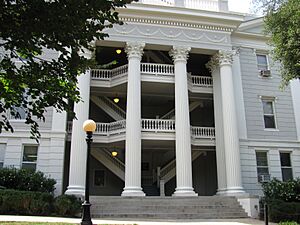University of Georgia desegregation riot facts for kids
The University of Georgia desegregation riot was a big event that happened on January 11, 1961. It involved a large group of people who were against racial integration. They protested when the University of Georgia (UGA) in Athens, Georgia allowed two African American students to enroll.
These students were Hamilton E. Holmes and Charlayne Hunter. They had worked hard to get into the university. A court even ordered the school to accept them. On January 11, 1961, after they had signed up for classes, about 1,000 people gathered. Some were from the Ku Klux Klan. They caused a disturbance outside Charlayne Hunter's dormitory.
After the event, Holmes and Hunter were temporarily suspended by the university. But a court quickly ordered them to be allowed back. Some people involved in the disturbance were arrested. Several students faced school punishment. An investigation by the Federal Bureau of Investigation found that some organizers had talked to state officials. These officials seemed to approve of the disturbance.
After this event, Holmes and Hunter continued their studies at UGA. They both graduated and had successful careers. This event at UGA helped other universities in Georgia to also become integrated in the years that followed.
What Happened Next
Right after the disturbance, the university's dean suspended Holmes and Hunter. He said it was for their safety and the safety of other students. But the very next evening, many teachers at the university gathered. They wanted the two students to be allowed back. More than 400 teachers signed a paper asking for this.
On January 13, a judge ordered that Holmes and Hunter be allowed back. They started attending classes the next school day. The university also punished four students who had helped organize the disturbance. Another 18 students faced school discipline. Four members of the Ku Klux Klan and two students were arrested for their part in the event.
The return of Holmes and Hunter also changed a state law in Georgia. This law had stopped state money from going to integrated universities. But the Georgia General Assembly later voted to get rid of that law. Holmes and Hunter later said they did not enjoy their time at UGA. However, they were not physically threatened again. Both students graduated and had good careers.
After UGA, other universities in Georgia also became integrated. These included the Georgia Institute of Technology in 1961. Emory University and Mercer University followed in 1963. Berry College integrated in 1964. In 2001, UGA honored Holmes and Hunter. They renamed their main academic building the Holmes–Hunter Building.
State Officials and the Event
University officials tried to say that students were not the main organizers of the disturbance. They blamed outsiders and said people were just upset about a basketball game. But historian Robert A. Pratt says there is little proof for this. He believes there is strong evidence that law students helped plan the event. Some of these students were from the Demosthenian Literary Society.
During an investigation by the Federal Bureau of Investigation, one leader of the disturbance said he talked to state officials every day before it happened. Newspapers like The Atlanta Journal and The Atlanta Constitution also reported something similar. Eyewitnesses said organizers bragged about their connections to state officials. They claimed they were told state police would not stop the disturbance.
Roy V. Harris, an important figure in Georgia politics, seemed to agree with these claims. He told the press that "people holding high official positions in the Capitol" had encouraged the people involved. In the end, no one who organized the disturbance was charged with trying to cause it. No state official has ever admitted to working with the people who caused the disturbance.


